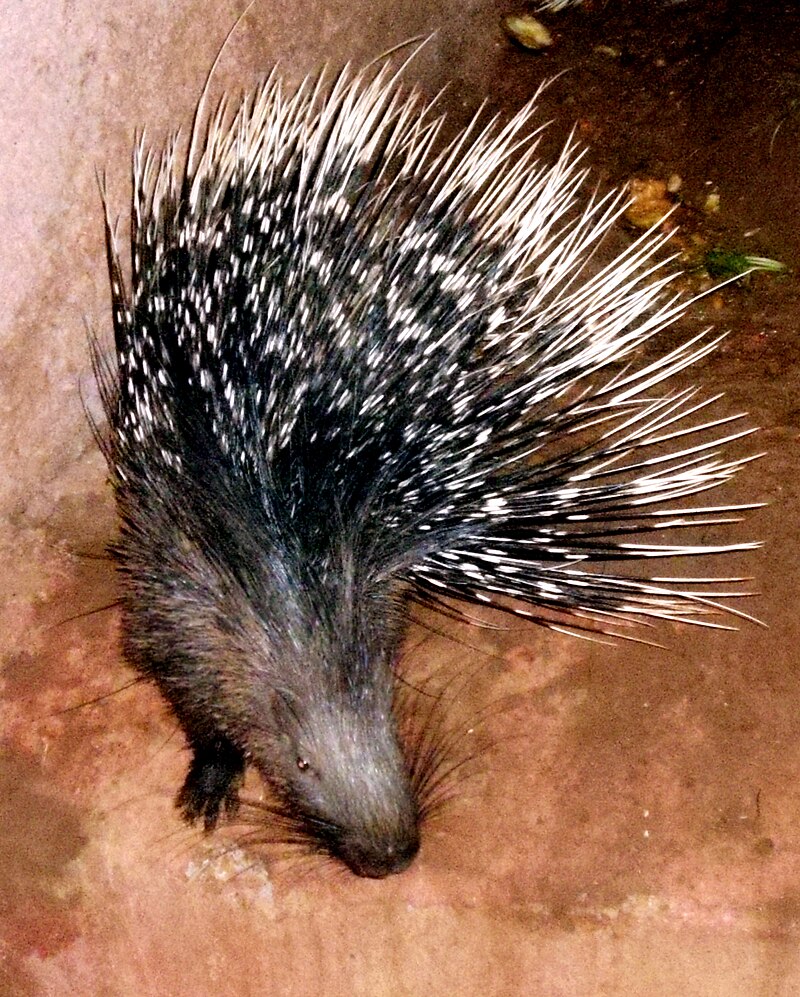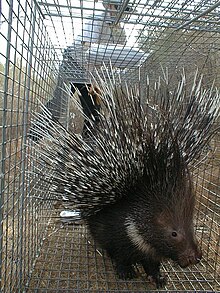
Description
The Indian crested porcupine is a large rodent, weighing 11–18 kg.[2] Their body (from the nose to the base of the tail) measures between 70–90 cm, with the tail adding an additional 8–10 cm.[3] The lifespan of wild Indian crested porcupines is unknown, but the oldest known captive individual was a female that lived to be 27.1 years old.[2]It is covered in multiple layers of modified hair called quills, with longer, thinner quills covering a layer of shorter, thicker ones.[2] The quills are brown or black with alternating white and black bands.[4] They are made of keratin and are relatively flexible.[4] Each quill is connected to a muscle at its base, allowing the porcupine to raise its quills when it feels threatened.[4] The longest quills are located on the neck and shoulder, where the quills form a "skirt" around the animal.[4] These quills can grow up to 51 cm (20 in) long,[4] with most measuring between 15–30 cm.[5] Smaller (20 cm) and more rigid quills are packed densely on the back and rump.[4] These smaller quills are used to stab at potential threats.[4] The base of the tail contains shorter quills that appear white in color, with longer, hollow quills that the porcupine can rattle to produce a warning sound when threatened.[6] Contrary to popular belief, Indian crested porcupines (like all porcupines) cannot shoot their quills.[4]
The Indian crested porcupine has a stocky build with a low surface area to volume ratio, which aids in heat conservation.[7] It has broad feet with long claws used for burrowing.[2] Like all porcupines, the Indian crested porcupine has a good sense of smell and sharp, chisel-like incisors.[4]
Distribution and habitat
Indian crested porcupine on a rocky hillside
In 2018, a porcupine was spotted at Wadi Wurayah in the United Arab Emirates.[10][11]
Diet
A captive H. indica eating plant material
These porcupines can act as substantial habitat modifiers when excavating for tubers.[15][16] They are also considered serious agricultural pests in many parts of their range due to their taste for agricultural crops.[9][17] For these reasons, they are often regarded as a nuisance.[1]
Behavior
Like other Old World porcupines, the Indian crested porcupine is nocturnal.[2] Both adults and weaned juveniles spend an average of 7 hours foraging every night.[9][18][19] They tend to avoid moonlight in the winter months, which could be a strategy to evade predation.[18] However, during summer months they do not avoid moonlight (likely because there are less dark hours during which to forage), but instead tend to stay closer to their dens.[18] During the day, they remain in their dens,[19][20] but throughout the winter, they occasionally emerge from their dens during daylight hours to bask in the sun.[7]The Indian crested porcupine is semifossorial.[2] They live in natural caves or in excavated burrows.[19][20] Because they do not climb or jump well, they spend most of their lives on or under the ground.[4] However, they are good swimmers.[4]
Predators of the Indian crested porcupine include large cats,[21][22] caracals, wolves, striped hyenas, Asian wild dogs, Saltwater crocodiles [23] and humans.[18] When excited or scared, a porcupine stands its quills up to appear larger.[4] It can also rattle the hollow quills at the base of its tail, stomp its feet, growl, grunt, or charge backward into the threat.[4]
Reproduction
Indian crested porcupines mate in February and March.[24] Gestation lasts an average of 240 days.[5] A female gives birth to one brood of two to four offspring per year.[3] Young are born with open eyes and are covered in short, soft quills that harden within a few hours after birth.[2] Young are fully weaned 13–19 weeks after birth, but remain in the den with parents and siblings until sexual maturity around 2 years of age.[24] The Indian crested porcupine is usually monogamous, and both parents live in the den with their offspring throughout the year.[2]Conservation
H. indica in a trap
The Indian crested porcupine is protected under the India Schedule IV of the Indian Wildlife Protection Act of 1972, amended up to 2002.[2] Nonetheless, because they are destructive to gardens and agricultural crops, porcupines are widely hunted.[5][25] A large trade of these porcupines exists for consumption and medicinal use.[2] Despite being considered a pest, Indian crested porcupines play an important role in spreading seeds and pollen.[2]



No comments:
Post a Comment
Note: Only a member of this blog may post a comment.